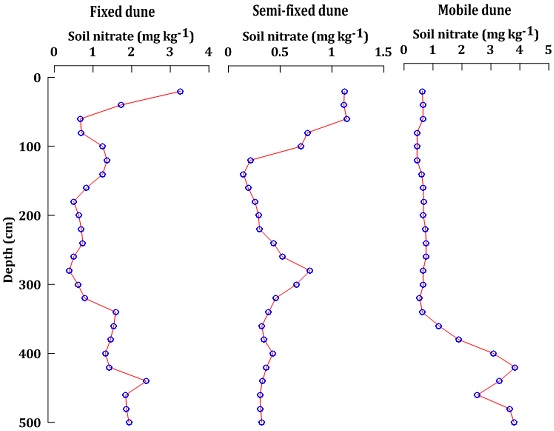Desert soils are generally thought to be nutrient poor and low in total nitrogen (N). However, recent studies have demonstrated that desert subsoil represents a large reservoir of bioavailable N in the form of nitrate, suggesting that this N pool has been previously overlooked. Investigations of this subsoil N storage could increase estimates of vadose-zone N content by 14 to 71% for warm deserts and arid shrublands worldwide. Moreover, subsoil nitrate may contaminate groundwater and exert further negative effects after land-use or climate change in deserts. Therefore, additional investigations of subsoil nitrate reservoirs are required in the field of desert environmental research.
China contains several of the largest areas of desert and desertified land in the world. The total area of desert in China is estimated at approximately 1.53×106 km2, and deserts occupy approximately 15.9% of the total national land area. Numerous studies have suggested that desert subsoil in China could accumulate a large amount of bioavailable N from massive atmospheric nitrate depositions and active N fixation by biological soil crusts. However, to our knowledge, few studies have been conducted to characterize the subsoil nitrate distribution and dynamics in Chinese deserts. Moreover, numerous studies have demonstrated that the climate of northwest China has experienced an increasing warming and wetting trend over the past several decades and suggest that this trend will continue throughout the 21st century. Increases in precipitation would lead to additional leaching and mobilization of subsoil nitrate in deserts and heighten the environmental risk to groundwater. Therefore, investigations of the distribution characteristics of subsoil nitrate reservoirs in Chinese deserts are urgently required, and the resulting information will broaden our understanding of desert N cycling.
The Mu Us desert is located in the southeastern region of the Ordos Plateau in northern China and covers an area of 40000 km2. Over the past decade, the region has been the most active area of economic growth in China because of its rich coal, oil and natural gas resources. Groundwater is the main water source in the Mu Us desert, and soil nitrate is readily mobilized to the groundwater because of the shallow groundwater table. Moreover, the rapid development of petroleum and coal industries in the region could significantly increase the atmospheric deposition of nitrate and pose an additional potential threat to the groundwater. However, little is known of the distribution patterns of subsoil nitrate in the region, which limits our understanding of whether a subsoil nitrate reservoir occurs in the area and how it might be characterized.
In this study, Dr JIN Zhao, from the Institute of Earth Environment, Chinese Academy of Sciences, leaded a group and investigated the distribution patterns of soil total N, nitrate, ammonium, and stable isotopic ratios of 15N (δ15N) in shallow (1 m) and subsoil (5 m) profiles in three types of dunes in the Mu Us desert. They found that soil N retention of the fixed and semi-fixed dunes followed a progressive nutrient depletion pattern in shallow soil profiles, whereas the subsoil nitrate of the fixed, semi-fixed and mobile dunes maintained a conservative accumulation pattern, which indicate that the subsoil of the Mu Us desert may act as a reservoir of available nitrate (Fig. 1). Furthermore, a soil δ15N analysis indicate that the nitrate content of the fixed dune is likely derived from soil nitrification, whereas the nitrate content in the mobile dune is derived from atmospheric nitrate deposition. Within the context of looming climate change and intensifying human activities, the subsoil nitrate content in the deserts of northern China could become mobilized and increase environmental risks to groundwater.
Publication: Jin Z, Zhu Y J, Li X R, Dong Y S, An Z S. 2015. Soil N retention and nitrate leaching in three types of dunes in the Mu Us desert of China. Scientific Reports, 5: 14222, doi: 10.1038/srep14222
Contact:
JIN Zhao
State Key Laboratory of Loess and Quaternary Geology, Institute of Earth Environment, Chinese Academy of Sciences
Email: jinzhao@ieecas.cn

Fig. 1 Distribution patterns of soil nitrate in the 5 m soil layer (Image by JIN Zhao)
 © 2015 Institute of Earth Environment,CAS
© 2015 Institute of Earth Environment,CAS Address:No. 97 Yanxiang Road, Xi'an 710061, Shaanxi, China

 Location :
Location :